
Catacombs are man-made subterranean passageways for religious practice. Any chamber used as a burial place is a catacomb, although the word is most commonly associated with the Roman Empire.

The Catacombs of Rome are ancient catacombs, underground burial places in and around Rome, of which there are at least forty, some rediscovered only in recent decades. Though most famous for Christian burials, either in separate catacombs or mixed together, Jews and also adherents of a variety of pagan Roman religions were buried in catacombs, beginning in the 2nd century AD, occasioned by the ancient Roman ban on burials within a city, and also as a response to overcrowding and shortage of land. The most extensive and perhaps the best known is the Christian Catacomb of Callixtus located near the Park of the Caffarella, but there are other sites, both Christian and not, scattered around the city, some of which are now engulfed by modern urban sprawl.

Early Christian art and architecture or Paleochristian art is the art produced by Christians or under Christian patronage from the earliest period of Christianity to, depending on the definition used, sometime between 260 and 525. In practice, identifiably Christian art only survives from the 2nd century onwards. After 550 at the latest, Christian art is classified as Byzantine, or of some other regional type.

The Basilica Papale di San Lorenzo fuori le mura is a Roman Catholic papal minor basilica and parish church, located in Rome, Italy. The Basilica is one of the Seven Pilgrim Churches of Rome and one of the five "papal basilicas", each of which was assigned to the care of a Latin Church patriarchate. The basilica was assigned to the Patriarchate of Jerusalem. The basilica is the shrine of the tomb of its namesake, Lawrence, one of the first seven deacons of Rome who was martyred in 258. Many other saints and Pope Pius IX are also buried at the Basilica, which is the centre of a large and ancient burial complex.

Benjamin Mazar was a pioneering Israeli historian, recognized as the "dean" of biblical archaeologists. He shared the national passion for the archaeology of Israel that also attracts considerable international interest due to the region's biblical links. He is known for his excavations at the most significant biblical site in Israel: south and south west of the Temple Mount in Jerusalem. In 1932 he conducted the first archaeological excavation under Jewish auspices in Israel at Beit She'arim and in 1948 was the first archaeologist to receive a permit granted by the new State of Israel. Mazar was trained as an Assyriologist and was an expert on biblical history, authoring more than 100 publications on the subject. He developed the field of historical geography of Israel. For decades he served as the chairman of the Israel Exploration Society and of the Archaeological Council of Israel. Between 1951 and 1977, Mazar served as Professor of Biblical History and Archaeology at the Hebrew University of Jerusalem. In 1952 he became Rector of the university and later its president for eight years commencing in 1953.
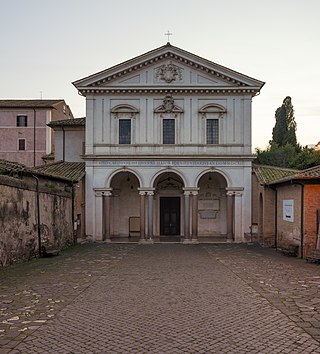
San Sebastiano fuori le mura, or San Sebastiano ad Catacumbas, is a minor basilica in Rome, Central Italy. Up to the Great Jubilee of 2000, San Sebastiano was one of the Seven Pilgrim Churches of Rome, and many pilgrims still favour the traditional list.
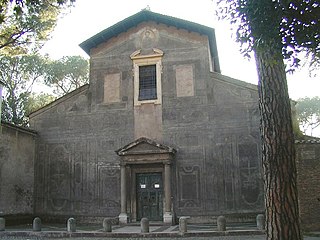
Santi Nereo ed Achilleo is a fourth-century basilica church in Rome, Italy, located in via delle Terme di Caracalla in the rione Celio facing the main entrance to the Baths of Caracalla. It has been the titular church of Cardinal Celestino Aós Braco since 28 November 2020.

The Catacomb of Priscilla is an archaeological site on the Via Salaria in Rome, Italy, situated in what was a quarry in Roman times. This quarry was used for Christian burials from the late 2nd century through the 4th century. This catacomb, according to tradition, is named after the wife of the Consul Manius Acilius Glabrio; he is said to have become a Christian and was killed on the orders of Domitian. Some of the walls and ceilings display fine decorations illustrating Biblical scenes.

Beit She'arim necropolis is an extensive necropolis of rock-cut tombs near the remains of the ancient Jewish town of Beit She'arim. In early modern times the site was the Palestinian village of Sheikh Bureik; it was depopulated in the 1920s as a result of the Sursock Purchases, and identified as Beit She'arim in 1936 by historical geographer Samuel Klein.
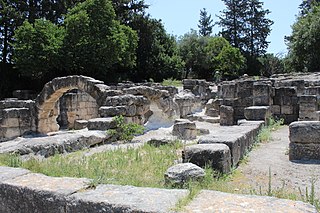
Beit She'arim or Besara was a Roman-era Jewish village from the 1st century BCE until the 3rd century CE which, at one time, was the seat of the Sanhedrin. The village was later known as Sheikh Bureik, and was depopulated in the early 1920s as a result of the Sursock Purchase.
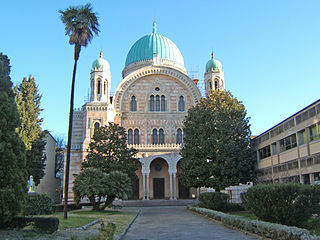
The Great Synagogue of Florence or Tempio Maggiore is one of the largest synagogues in South-central Europe, situated in Florence, in Italy. The synagogue of Florence was one of the most important synagogues built in Europe in the age of the Jewish emancipation, reached by the Jewish communities living in the Grand Duchy of Tuscany in 1848.

The Catacomb of Generosa is a catacomb of Rome (Italy), located in Via delle Catacombe di Generosa, close to a big bight of river Tiber on the right bank, in the Portuense quarter.

The Catacomb of Saint Agnes is one of the catacombs of Rome, placed at the second mile of via Nomentana, inside the monumental complex of Sant'Agnese fuori le mura, in the Quartiere Trieste.

The Appian Way Regional Park is the second-largest urban park of Europe, after Losiny Ostrov National Park in Moscow. It is a protected area of around 4580 hectares, established by the Italian region of Latium. It falls primarily within the territory of Rome but parts also extend into the neighbouring towns of Ciampino and Marino.
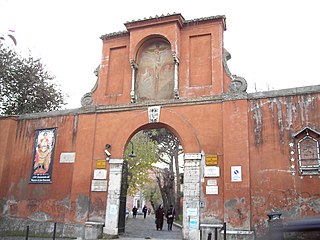
The Catacomb of San Pancrazio is a catacomb of Rome (Italy), located in the Via Aurelia, within the modern Quartiere Gianicolense.

The Catacombs of Saint Gaudiosus are underground paleo-Christian burial sites, located in the northern area of the city of Naples.

The Catacombs of San Sebastiano are a hypogeum cemetery in Rome, Italy, rising along Via Appia Antica, in the Ardeatino Quarter. It is one of the very few Christian burial places that has always been accessible. The first of the former four floors is now almost completely destroyed.

The Jewish Museum of Rome is situated in the basement of the Great Synagogue of Rome and offers both information on the Jewish presence in Rome since the second century BCE and a large collection of works of art produced by the Jewish community. A visit to the museum includes a guided tour of the Great Synagogue and of the smaller Spanish Synagogue in the same complex.

The Catacomb of Saint Thecla is a Christian catacomb in the city of Rome, near the Via Ostiense and the Basilica of Saint Paul Outside the Walls, in the southern quarter of the ancient city. The catacomb was constructed in the fourth century of the Common Era, linked with a basilica to the saint that is alluded to in literature. Because of the enigmatic endings of the legends of Saint Thecla of Iconium, it is still unknown whether the tomb belongs to the saint or if it belongs to a different noblewoman. Regardless, the tomb is an example of early Christian funerary practice and artwork. The most recent discovery in the catacomb was the depiction of several apostles, hypothesized to be their earliest portrayals. Of particular interest to many is the portrait of the Apostle Paul.
Three extensive underground collective burial columbaria at Vigna Codini were discovered in the mid-nineteenth century, near the Aurelian Walls between the via Appia and via Latina in Rome, Italy. Although this area on the outskirts of Rome was traditionally used for elite burials, these columbaria that emerged in the Augustan era seem to have been reserved for non-aristocratic individuals, including former slaves. Not to be confused with the later phenomenon of catacomb inhumations, these subterranean chambers contained niches for cremation urns. The columbaria at Vigna Codini are among some of the largest in Rome.





















